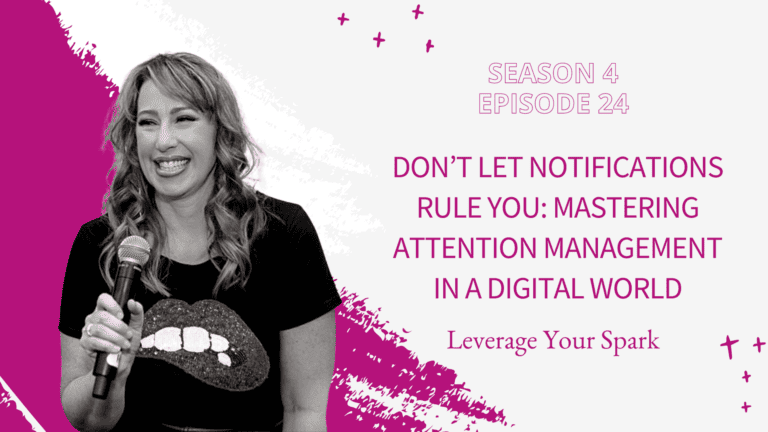Don’t Let Notifications Rule You: Mastering Attention Management in a Digital World

Unless you’ve been hiding under a rock, you’ve likely heard about the myth of multitasking (that we don’t really do it, we just task switch) and that there are real “costs” to switching tasks as it takes our brains awhile to get back in the groove after we’ve been distracted by something else. One of the biggest threats to our attention and ability to focus is notifications.
Regain Focus and Productivity: Taking Control of Your Notifications
Notifications, when used intentionally and sparingly, can be extremely useful. Even critical in some cases like the reminder to pick up your kid from school or take your medication. But, I think we’re all likely to agree that because we live with all the tiny devices, notifications are more likely at this point to be hindering our ability to get things done.
What if you could take back control of your attention? Get back in the driver’s seat for your focus and productivity? One big step in the right direction is to take back control of your notifications and limit what gets the right to demand your attention.
I’m also not living under a rock here, I know this is a big ask because research has shown that the human brain is wired to pay attention to novel stimuli in the environment. The kind of thing that kept us alive on the savannah. Notifications, by their very nature, are novel and therefore capture attention. These notifications can be habit-forming because you don’t know whether it’s something exciting or mundane, and this uncertainty can make checking notifications pleasurable and addictive.
Taking Control of Notifications: Reclaim Your Attention and Time
So if you are getting more notifications than are useful and you want to claw back your attention (and ultimately time), here’s some ways to get started:
- Decide what notifications are critical for you. Just because your doorbell has a motion sensor, doesn’t mean you need to get notifications when it gets triggered. Make a list. If there are more than 4 items on the list, you might consider cutting one more.
- Turn off all notifications except those that are critical. Now, before you freak out, this doesn’t have to be forever. Maybe you try it for 3 days or a week and see how it goes. And yes, this takes some doing as all the apps try to turn on their notifications when installed. Also, notifications aren’t just dings and pop-up messages. That little number sitting on the corner of your email icon is also a notification – you don’t need that either.
- After your trial run, check in with yourself on how it went. Were you able to focus more? Were there any notifications you turned off that you actually needed? Were there any notification you left on that you actually don’t need? Then adjust accordingly.
Regaining Control: Protecting Your Attention in an Attention-Driven World
We live in a world where our attention has become currency, so it is up to us how we spend it. The number of things vying for our attention isn’t going to diminish, so it we’re responsible to build the skills, systems and habits to protect our attention, and thus our time and effectiveness. This is great to do for ourselves, but is also important to address for our teams. Each new system we implement will have notifications, so it can be helpful to define how notifications are getting used on the onset of a system to help prevent overwhelm and attention fatigue.
In the next episode I’ll be discussing the issue of the overflowing inbox and the way I am getting to an empty inbox everyday.
If you enjoyed this episode, you can head over to leverageyourspark.com to subscribe, leave us a review or share with a friend. Everyone deserves to have less stress and more impact!

